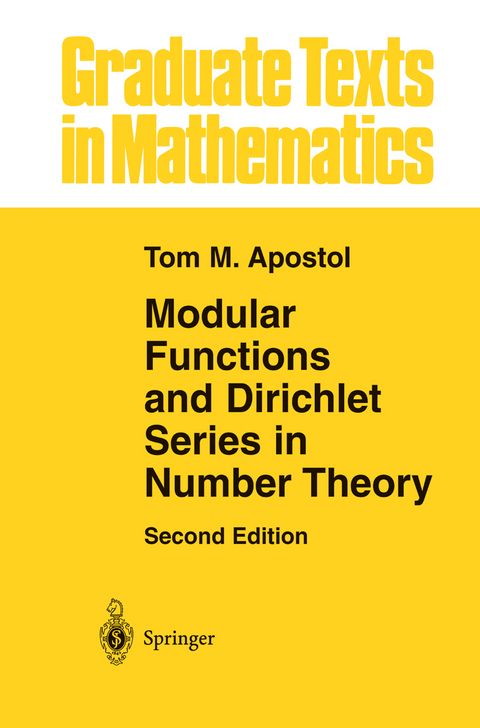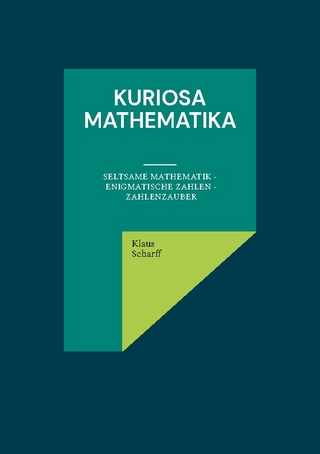
Modular Functions and Dirichlet Series in Number Theory
Springer-Verlag New York Inc.
978-1-4612-6978-6 (ISBN)
1 Elliptic functions.- 1.1 Introduction.- 1.2 Doubly periodic functions.- 1.3 Fundamental pairs of periods.- 1.4 Elliptic functions.- 1.5 Construction of elliptic functions.- 1.6 The Weierstrass p function.- 1.7 The Laurent expansion of p near the origin.- 1.8 Differential equation satisfied by p.- 1.9 The Eisenstein series and the invariants g2 and g3.- 1.10 The numbers e1, e2, e3.- 1.11 The discriminant ?.- 1.12 Klein’s modular function J(?).- 1.13 Invariance of J under unimodular transformations.- 1.14 The Fourier expansions of g2(?) and g3(?).- 1.15 The Fourier expansions of ?(?) and J(?).- Exercises for Chapter 1.- 2 The Modular group and modular functions.- 2.1 Möbius transformations.- 2.2 The modular group ?.- 2.3 Fundamental regions.- 2.4 Modular functions.- 2.5 Special values of J.- 2.6 Modular functions as rational functions of J.- 2.7 Mapping properties of J.- 2.8 Application to the inversion problem for Eisenstein series.- 2.9 Application to Picard’s theorem.- Exercises for Chapter 2.- 3 The Dedekind eta function.- 3.1 Introduction.- 3.2 Siegel’s proof of Theorem 3.1.- 3.3 Infinite product representation for ?(?).- 3.4 The general functional equation for ?(?).- 3.5 Iseki’s transformation formula.- 3.6 Deduction of Dedekind’s functional equation from Iseki’s formula.- 3.7 Properties of Dedekind sums.- 3.8 The reciprocity law for Dedekind sums.- 3.9 Congruence properties of Dedekind sums.- 3.10 The Eisenstein series G2(?).- Exercises for Chapter 3.- 4 Congruences for the coefficients of the modular function j.- 4.1 Introduction.- 4.2 The subgroup ?0(q).- 4.3 Fundamental region of ?0(p).- 4.4 Functions automorphic under the subgroup ?0(p).- 4.5 Construction of functions belonging to ?0(p).- 4.6 The behavior of fp under thegenerators of ?.- 4.7 The function ?(?) = ?(q?)/?(?).- 4.8 The univalent function ?(?).- 4.9 Invariance of ?(?) under transformations of ?0(q).- 4.10 The function jp expressed as a polynomial in ?.- Exercises for Chapter 4.- 5 Rademacher’s series for the partition function.- 5.1 Introduction.- 5.2 The plan of the proof.- 5.3 Dedekind’s functional equation expressed in terms of F.- 5.4 Farey fractions.- 5.5 Ford circles.- 5.6 Rademacher’s path of integration.- 5.7 Rademacher’s convergent series for p(n).- Exercises for Chapter 5.- 6 Modular forms with multiplicative coefficients.- 6.1 Introduction.- 6.2 Modular forms of weight k.- 6.3 The weight formula for zeros of an entire modular form.- 6.4 Representation of entire forms in terms of G4 and G6.- 6.5 The linear space Mk and the subspace Mk,0.- 6.6 Classification of entire forms in terms of their zeros.- 6.7 The Hecke operators Tn.- 6.8 Transformations of order n.- 6.9 Behavior of Tnf under the modular group.- 6.10 Multiplicative property of Hecke operators.- 6.11 Eigenfunctions of Hecke operators.- 6.12 Properties of simultaneous eigenforms.- 6.13 Examples of normalized simultaneous eigenforms.- 6.14 Remarks on existence of simultaneous eigenforms in M2k,0.- 6.15 Estimates for the Fourier coefficients of entire forms.- 6.16 Modular forms and Dirichlet series.- Exercises for Chapter 6.- 7 Kronecker’s theorem with applications.- 7.1 Approximating real numbers by rational numbers.- 7.2 Dirichlet’s approximation theorem.- 7.3 Liouville’s approximation theorem.- 7.4 Kronecker’s approximation theorem: the one-dimensional case.- 7.5 Extension of Kronecker’s theorem to simultaneous approximation.- 7.6 Applications to the Riemann zeta function.- 7.7 Applications to periodic functions.- Exercisesfor Chapter 7.- 8 General Dirichlet series and Bohr’s equivalence theorem.- 8.1 Introduction.- 8.2 The half-plane of convergence of general Dirichlet series.- 8.3 Bases for the sequence of exponents of a Dirichlet series.- 8.4 Bohr matrices.- 8.5 The Bohr function associated with a Dirichlet series.- 8.6 The set of values taken by a Dirichlet series f(s) on a line ? = ?0.- 8.7 Equivalence of general Dirichlet series.- 8.8 Equivalence of ordinary Dirichlet series.- 8.9 Equality of the sets Uf(?0) and Ug(?0) for equivalent Dirichlet series.- 8.10 The set of values taken by a Dirichlet series in a neighborhood of the line ? = ?0.- 8.11 Bohr’s equivalence theorem.- 8.12 Proof of Theorem 8.15.- 8.13 Examples of equivalent Dirichlet series. Applications of Bohr’s theorem to L-series.- 8.14 Applications of Bohr’s theorem to the Riemann zeta function.- Exercises for Chapter 8.- Supplement to Chapter 3.- Index of special symbols.- Index 201.
| Erscheint lt. Verlag | 2.10.2012 |
|---|---|
| Reihe/Serie | Graduate Texts in Mathematics ; 41 |
| Zusatzinfo | X, 207 p. |
| Verlagsort | New York, NY |
| Sprache | englisch |
| Maße | 155 x 235 mm |
| Themenwelt | Mathematik / Informatik ► Mathematik ► Arithmetik / Zahlentheorie |
| Mathematik / Informatik ► Mathematik ► Wahrscheinlichkeit / Kombinatorik | |
| Schlagworte | Elliptische Funktion • Modulfunktion |
| ISBN-10 | 1-4612-6978-4 / 1461269784 |
| ISBN-13 | 978-1-4612-6978-6 / 9781461269786 |
| Zustand | Neuware |
| Haben Sie eine Frage zum Produkt? |
aus dem Bereich


